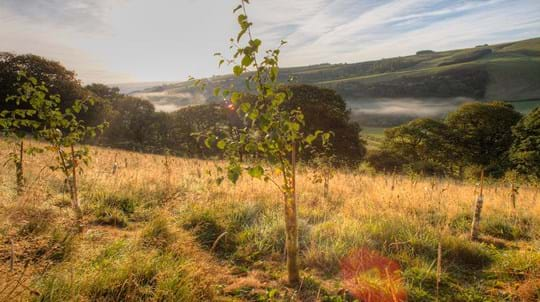Buy hedging plants
We've got beautiful hedgerow trees perfect for gardens. Delivery is free and every purchase funds our vital work for woods, trees and wildlife.
Visit our Tree Shop
Content manager, botanist and tree lover
Thinking of planting a native hedge? It could be one of the best decisions you'll ever make, with benefits ranging from year-round beauty to boosting biodiversity.
Autumn and winter are the best times to plant a hedge. To get you started, here are our recommendations for nine of the best native hedge plants and the amazing benefits they'll bring.
If you're inspired to get planting, here are 10 native deciduous and evergreen hedge plants suitable for most gardens.
The leaves of beech turn a bright bronze-gold in autumn and stay on the hedge well into the depths of winter.
Beech is a majestic species, perfectly suited to life as a hedgerow. Its glossy green leaves have wavy edges that turn a coppery-bronze and remain on the tree throughout autumn and winter. It's also fast growing, so a beech hedge is perfect for screening and privacy.
This species is a haven for wildlife. It supports around 100 different insects including caterpillars of the barred hook-tip, clay triple-lines and olive crescent moths. The seeds are eaten by mice, voles, squirrels and birds.
Type: deciduous
Blackthorn hedges are spiky, dense and impenetrable - making them brilliant natural security boundaries.
This spiny, densely branched shrub is great for hedging. You'll get a frothy mass of white blossom early in the spring (March) followed by purple-black fruits (sloes) later in the summer.
Blackthorn is a superb tree for wildlife as it provides food for over 100 insect species including black and brown hairstreak butterflies and many moths including lackey, magpie and swallowtail. Because it flowers so early in the year, it's a good source of nectar for solitary bees and other pollinators. Its fruit is important for birds and small mammals in autumn and winter while the thorny cover provides a habitat for nesting and roosting birds.
Take care: while blackthorn is brilliant for biodiversity, its suckering nature may make it less suitable for gardens, more formal spaces or places where you want a neat aesthetic. Weigh up your priorities: do you want a wild haven or sculpted space? Consider your needs and space carefully before choosing this rustic, eco-friendly option.
Type: deciduous
Box can be clipped into topiary shapes and also grows well in containers so is a good choice if you only have a small outdoor space or balcony.
Use box to create low-level hedges or borders. It can also be clipped and trained into elaborate topiary shapes if you're creative. It's slow growing with dense, evergreen foliage.
In April and May, box produced small yellow flowers that offer a food source for bees as well as providing a dense, sheltered habitat for small birds, mammals and invertebrates.
Type: evergreen
Dogwood bursts into colour in the colder months, bearing bright, shimmering red stems that will brighten up your hedgerow in winter.
A hedgerow that includes dogwood will give your garden a beautiful, crimson-red glow as its twigs turn red in winter. In spring you'll get creamy white flowers.
If you want to attract wildlife to your garden, dogwood is a winner with around 65 species of insect feeding on it. Its leaves are food for the caterpillars of green hairstreak and holly blue butterflies and its spring blossom attracts many pollinators. Later in the summer, dogwood berries are favoured by birds such as starlings, thrushes and robins.
Type: deciduous
We've got beautiful hedgerow trees perfect for gardens. Delivery is free and every purchase funds our vital work for woods, trees and wildlife.
Visit our Tree ShopIt's a prolific producer of flowers and berries, and its dense, thorny growth (hence its alternative name - quickthorn) makes a hawthorn hedge a great choice if you're looking for security.
A hardy, resilient hedgerow classic and one of the prettiest native trees. In May you'll get clouds of creamy or pink-tinged blossom followed by bright red berries later in the summer.
Hawthorn supports hundreds of wildlife species. The fruit is important for birds, especially thrushes into the winter and its dense, thorny growth provides cover for nesting and roosting. Its flowers and leaves are a food source for insects.
Type: deciduous
An all-time favourite, bringing mid-winter cheer with its glossy, green leaves and bright berries.
If you want security, a holly hedge makes a great choice! It's bushy and evergreen and has leaves that are prickly enough to deter unwanted visitors from entering your garden.
It's also a great choice for wildlife. Holly flowers appear in clusters between April and May, providing a nectar source. Its berries are eaten by birds including thrushes, woodpigeons, finches and robins and its dense, twiggy growth is perfect as a bird roost and for sheltering invertebrates. The deep leaf litter that accumulates beneath a holly hedge is used by hibernating hedgehogs and other mammals.
Type: evergreen
Hardy, strong and easy to maintain, hornbeam resembles beech but its leaf edges are serrated (rather than wavy) and it bears pretty winged fruits from late summer.
Hornbeam hedges form a dense barrier with plenty of year-round interest with their lush foliage, catkins (bearing clusters of tiny flowers) in spring, and winged fruits (known as samaras) that develop later in the summer. It's a fantastic, extra-tough alternative to a beech hedge in exposed areas.
Hornbeam supports over 170 species of insects, some of which are hornbeam specialists including the caterpillars of some micromoths. Finches, tits and small mammals eat the seeds in autumn and since it can retain its brown leaves through winter, it provides shelter, roosting, nesting and foraging options for birds.
Type: deciduous
Once known as wizard's tree, rowan is fast growing, dense and tough and can be clipped to produce a thick and private hedge.
Rowan (mountain ash) is a great choice for a hedge. It is fast-growing, dense, and attractive, and supports a wide range of wildlife.
Rowan's flowers, fruit, and dense, feather-like foliage provide food and shelter for insects, birds, and mammals. It's also a hardy plant that can tolerate a variety of conditions, making it a good choice for gardens in both urban and rural areas.
Its five-petaled flowers are creamy-white and grow in clusters in May and June. They turn into crimson-red berries in late summer, and the foliage turns fiery rich in autumn.
Type: deciduous
Wayfaring tree is delightful in a hedgerow with its pretty, white flower clusters that develop into groups of bright berries that start off bright red and later turn black. Its foliage transforms to a stunning red in autumn.
A perfect ornamental plant for informal hedging, the wayfaring tree was often planted along waysides and paths (hence its name). It's grows quickly so if you're looking for a fast-growing hedge, this species will help you out.
Wayfaring tree supports over 30 species of insect including the impressive orange-tailed clearwing moth which spends two years as larvae in the stems. The early spring flowers are a food source for beetles and bees, and from mid-summer, the fruits are enjoyed by birds and small mammals.
Type: deciduous
Yew hedging is really easy to trim and maintain. It works well for clipping and shaping into topiary.
Yew is an evergreen with needle-like leaves and seeds that are enclosed in a red, fleshy berry-like structure. It brings structure and interest all year but especially in winter. It can be clipped and shaped into yew hedges and makes a gorgeous backdrop to flower beds or when layered with other hedges like hornbeam and box.
The fleshy red seed coverings (arils) are eaten by many birds including robins, starlings, fieldfares, blackbirds, and mammals such as squirrels and dormice. Its seed is eaten by greenfinch, bullfinch and hawfinch and its leaves are a food source for some caterpillars. Its dense, evergreen growth provides important cover for roosting birds and invertebrates.
Type: evergreen

We've got beautiful hedgerow trees perfect for gardens. Delivery is free and every purchase funds our vital work for woods, trees and wildlife.
Visit our Tree ShopPlant your hedge 1-1.5m back from your boundary line to give it space to grow without overhanging your neighbour's land or property.

Video
00:01:31

Plant trees
The small but mighty hedge shelters wildlife, cleans our air, captures carbon and much more. Explore how and when to plant and prune your hedge for the best results.

Plant trees
Once your trees are in the ground it’s important to care for them, especially in the first few years.

Visiting woods
See what's in season with our guide to sustainable foraging with top tips on how to pick, cook and eat wild plants.